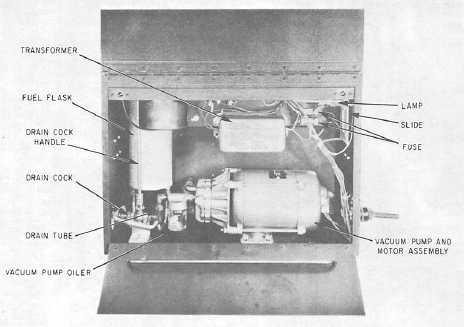Figure 3-7.—AEL Mk III (rear view).
retighten the nuts on the bulb holder. Refasten the
back of the instrument.
Calibrating the AEL MK III
The AEL Mk III comes with 2 WRATTEN
calibration filters that are wrapped in silver foil. A
Wratten calibration filter set is a pair of filters with a
known contamination value. The filters must be kept
in their silver foil wrappers so dust does not affect the
readings you get.
The reason you have to calibrate an AEL Mk III
is that you get wear on the photovoltaic cell, which
will give you improper readings if not constantly
checked.
NOTE
Calibrate quarterly or when a part is
replaced according to PMS.
When you handle the filters, use FORCEPS. The
area of contact should be within 1/4 inch of the edge
of the filter to avoid damage to the filter’s surface.
The calibration should be done in the following
manner:
1. Turn on the light and let it warm up for at
least 3 minutes.
2. Adjust the light intensity, using the rheostat
knob, until the milliammeter scale reads 0.6.
3. Pickup one Wratten filter, using the forceps.
Lift the photocell (or slide out the plate) and insert
the filter into the receptacle. Replace the photocell (or
slide in the plate) and record the milliammeter
reading in the log book.
4. After logging your results, remove the
Wratten filter and put it back into the foil wrapper.
5. Readjust the rheostat, if the milliammeter
reading is not 0.6.
6. Repeat steps 3 and 4 with the second Wratten
filter.
7. To obtain calibration point, subtract the lower
of the two milliammeter readings from the higher
reading. This difference is plotted on the calibration
chart versus the weight of contaminant per liter
given for the set of Wratten filters. A second point is
plotted at 0 milligrams per liter and 0.01 milliamps
change in light reading. Example (fig. 3-6):
a. Filter contamination factor = 1.6
milligrams per liter.
b. Difference between Wratten filters = 0.04
milliamps.
c. Plot this point with the calibration chart.
d. Plot second point where 0 milligrams per
liter and 0.01 milliamps BISECT.
3-19



